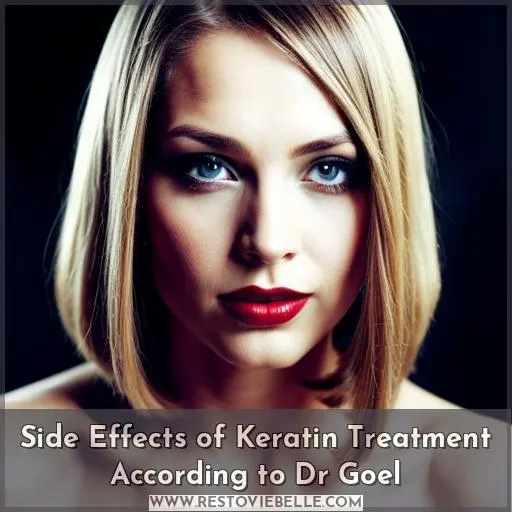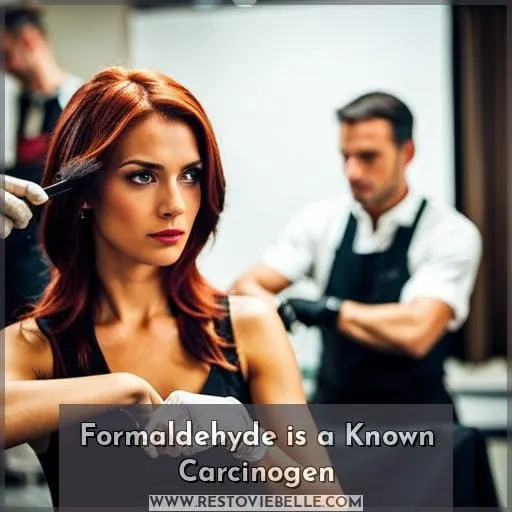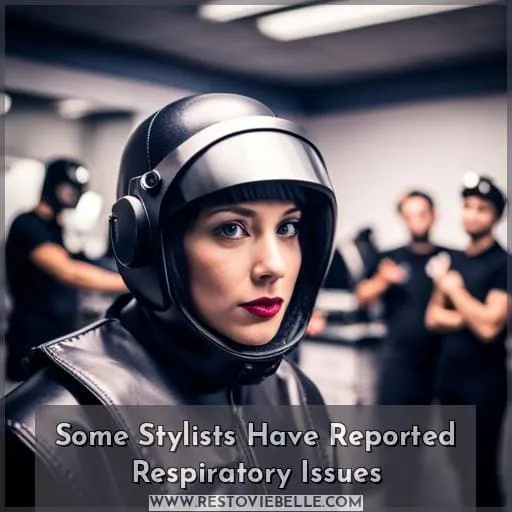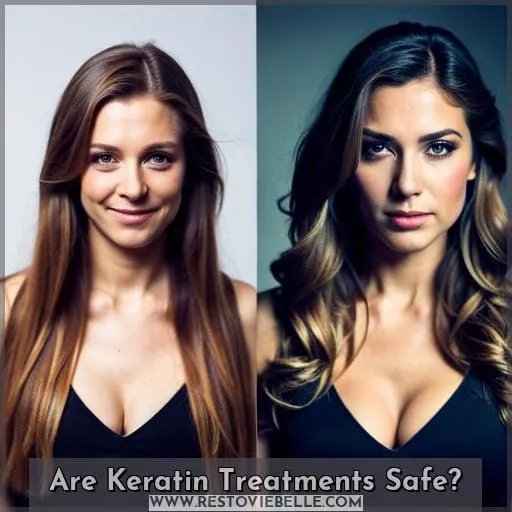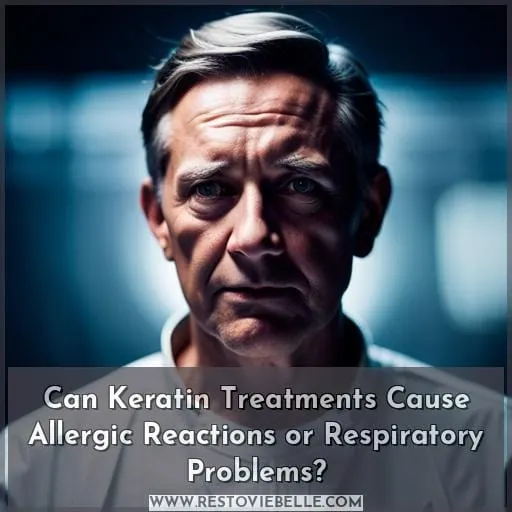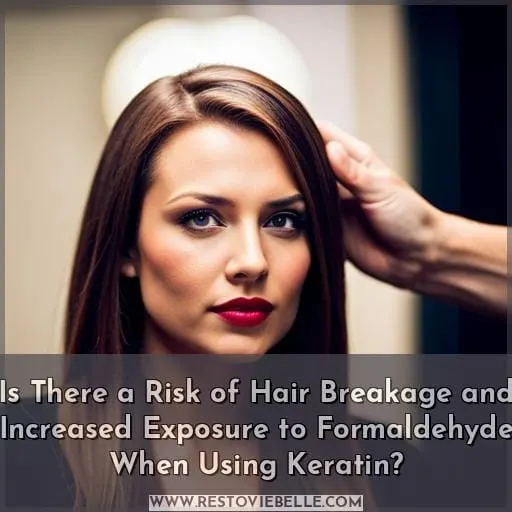This site is supported by our readers. We may earn a commission, at no cost to you, if you purchase through links.
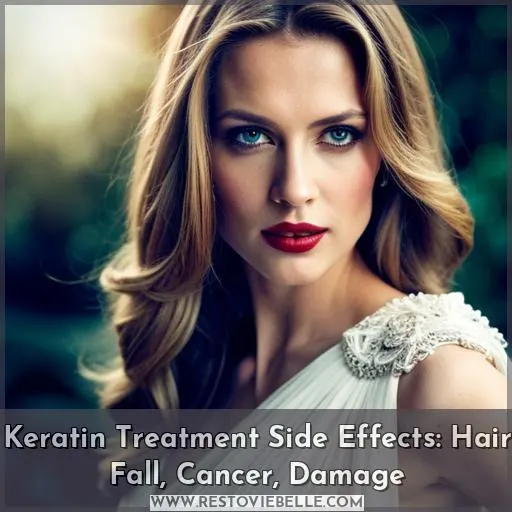 Are you considering getting a keratin treatment for your hair? You’re not alone. According to the American Academy of Dermatology, up to 90% of women and about 70% of men are now using chemical treatments on their hair.
Are you considering getting a keratin treatment for your hair? You’re not alone. According to the American Academy of Dermatology, up to 90% of women and about 70% of men are now using chemical treatments on their hair.
However, while these treatments can make our locks look luscious and sleek, they come with side effects that could be detrimental to both our health and hair in the long run.
This article discusses all the potential side effects of keratin treatment, including the risk of cancer, damage caused by formaldehyde exposure, as well as possible allergic reactions or respiratory problems associated with this beauty practice.
Table Of Contents
- Key Takeaways
- Side Effects of Keratin Treatment According to Dr Goel
- Formaldehyde is a Known Carcinogen
- Some Stylists Have Reported Respiratory Issues
- Are Keratin Treatments Safe?
- Can Keratin Treatments Cause Allergic Reactions or Respiratory Problems?
- Is There a Risk of Hair Breakage and Increased Exposure to Formaldehyde When Using Keratin?
- The Final Takeaway
- Conclusion
Key Takeaways
- Potential side effects of keratin treatments include an increased risk of cancer, exposure to formaldehyde, and allergies.
- Long-term use of keratin treatments can weaken the hair and lead to excessive hair loss.
- The heat and chemicals used during keratin treatments can damage the hair, causing breakage and thinning.
- Pregnant and breastfeeding women should avoid keratin treatments due to safety concerns.
Side Effects of Keratin Treatment According to Dr Goel
If you are considering a keratin treatment, it is important to be aware of the potential side effects associated with this hair straightening method. Dr. Goel warns that long-term use may cause cancer, damage your hair, and can lead to excessive hair fall.
Not Good for Long-term Hair Health
Repeated use of keratin treatments can weaken your hair over time, so be sure to choose the right product for you and limit usage accordingly. Dr. Anupriya Goel warns about its long-term effects on hair health, such as increased cancer risk and damage concerns.
Research safe products with low formaldehyde levels or explore alternatives like hot oil treatments for sleekness without harm.
Can Cause Hair Fall
Frequent keratin treatments can cause your hair to start thinning out, so be sure to use caution. Hair maintenance is important when opting for these treatments, and styling alternatives should be considered.
Pregnant women are advised against keratin treatment due to the associated risks, as well as those with healthy hair or a history of breakage. Hot oil treatments offer sleekness without adverse effects on the scalp and can help reduce the risk of hair fall caused by over-processing from keratin applications.
Can Cause Cancer
Exposure to formaldehyde in keratin treatments can increase your cancer risk. Hair damage, respiratory issues, skin reactions, and allergic reactions have all been reported with its use. To minimize health risks, opt for keratin-infused products or explore alternatives like hot oil treatments instead.
Be mindful of potential hair breakage due to the heat involved and always look out for concentrations of formaldehyde below 0.
Can Damage Your Hair
Using a keratin treatment without proper caution can cause damage to your hair. One study showed that up to 63% of those who used the product experienced some form of hair loss. Heat and chemical exposure during treatments may weaken or destroy protein bonds in the hair shaft, resulting in breakage and thinning.
To protect your hair health, look for products with low formaldehyde content or safer alternatives such as hot oil treatments at lower temperatures. Experts also suggest using heat protectants when styling and avoiding frequent shampooing to maintain healthy locks.
With careful product selection and expert opinions, you can keep your tresses beautiful while still protecting them from damage!
Formaldehyde is a Known Carcinogen
You should be aware that formaldehyde, a known carcinogen, is present in some keratin treatments. Formaldehyde exposure can cause various health issues such as eye irritation and headaches. Salon professionals are at greater risk due to repeated use of products containing this chemical.
Concentrations may even exceed the safe levels set by authorities in some cases.
Alternatives to these treatments and cautionary measures should be considered before going ahead with it. Products labeled as ‘formaldehyde-free’ may still contain it under different names so consumers need to look out for them carefully when shopping for hair straightening treatment solutions or other styling products involving heat applications like flat ironing etcetera.
Experts suggest alternatives such as heat styling combined with moisturizing natural oils instead of harsh chemicals which could damage hair shafts over time leading to thinning or weakening strands ultimately resulting into hair fall if not done properly after careful consideration on all available options based on individual’s specific needs along with expert opinions from qualified professionals and warnings issued by dermatologists regarding adverse effects associated with frequent use of Keratin Treatments especially during pregnancy or breastfeeding period.
Some Stylists Have Reported Respiratory Issues
Be aware that some stylists have reported respiratory issues due to formaldehyde exposure from keratin treatments. Hair experts and salon professionals suggest safety measures when it comes to choosing a shampoo for use after the treatment, as well as reducing the number of times you wash your hair.
Formaldehyde exposure may result in eye irritation and other respiratory symptoms such as coughing or difficulty breathing. These effects can become more severe over time if not addressed properly. It is important to consult with an expert before undergoing any kind of chemical-based hair straightening treatment so they can guide you on how best to minimize health risks associated with formaldehyde exposure during a keratin treatment process.
It is also advisable that people who are pregnant or breastfeeding avoid using products containing formaldehyde altogether due to its potential toxic effect on unborn babies and infants whose immune systems are still developing.
Are Keratin Treatments Safe?
Despite the potential health risks associated with formaldehyde exposure, many continue to question whether keratin treatments are safe. Pregnant women and those breastfeeding should avoid them as a precaution. Those with known hair allergies should also take care when using these products.
Stylists who frequently use such treatments may be at higher risk due to prolonged exposure, so safety protocols must be in place for their protection.
It is important to check labels carefully and ensure that formaldehyde levels remain below 0.002%. While it can provide temporary straightening results without heat damage or breakage, long-term effects on hair health have yet to be determined fully.
Alternatives like Japanese Straightening or semi-permanent straighteners require less maintenance but still need careful product choice for optimal results while avoiding harmful ingredients like sulfates and silicones which can dry out locks over time.
Ultimately, caution needs to be taken by everyone considering any chemical process on their mane.
Can Keratin Treatments Cause Allergic Reactions or Respiratory Problems?
Though it’s considered semi-permanent, keratin treatments may cause allergic reactions or respiratory problems due to formaldehyde exposure. The results of a treatment can be shiny hair with reduced frizz and increased manageability for up to five months.
However, safety concerns have been reported about formaldehyde present in some products. Salon workers exposed too frequently and at high concentrations could develop health risks such as eye irritation or headaches.
Customers seeking these treatments must also consider potential side effects like a sore throat or nosebleeds if their body reacts negatively to the product’s ingredients. An alternative to keratin treatments is the tourmaline hair-smoothing treatment, which does not contain any harsh chemicals.
It still provides salon-quality results without any long-term damage when used correctly with professional-grade products designed specifically for this procedure.
Allergic reactions and respiratory problems should always be taken into consideration before deciding on a keratin treatment. Frequent use can weaken the strands, potentially leading to breakage over time, even in those who do not experience adverse effects from its ingredients.
Is There a Risk of Hair Breakage and Increased Exposure to Formaldehyde When Using Keratin?
You may be at risk of hair breakage and increased exposure to formaldehyde when using keratin treatments, as studies suggest that salon professionals face a five times higher cancer risk due to repeated use.
Formaldehyde is released during these treatments and can weaken the hair shafts, leading to potential breakage over time.
It’s important for customers seeking a treatment like this one to look for products with low concentrations of formaldehyde or even 100% formaldehyde-free options such as Goldwell Kerasilk. Alternatives like Japanese Hair Straightening or hot oil treatments are also available which provide sleekness without any adverse effects on your health or hair health.
To further protect your tresses from heat damage, it’s recommended you use heat protectants while styling with flat irons.
Ultimately though, depending on the ingredients used in each product type, there may not be enough evidence yet regarding its effectiveness against frizz & shine enhancement.
The Final Takeaway
In the end, it’s important to weigh your options carefully when considering a keratin treatment and make sure you’re well-informed about potential risks. Formaldehyde exposure can cause eye irritation, headaches, and other health issues.
Salon stylists may face higher formaldehyde exposure due to repeated use of products with high concentrations.
Alternatives such as heat styling or hair moisturization should be considered if high levels of formaldehyde cannot be avoided. Pregnancy precautions must also be taken since frequent treatments can lead to hair fall or weakened strands over time.
Dr. Anupriya Goel warns about its adverse effects, but there are no therapeutic benefits for hair health from this type of treatment either, according to expert opinions including Nunzio Saviano and Giovanni Vaccaro.
They advise looking into 100% formaldehyde-free products like Goldwell Kerasilk or alternatives such as Japanese Hair Straightening, which don’t contain any harmful chemicals at all. Hot oil treatments remain an effective way to achieve sleek locks without having any side effects while protecting the natural state of your tresses.
Regular upkeep by using natural moisturizers, reducing shampoo use, and always checking product labels before choosing them is also recommended.
Conclusion
In a nutshell, keratin treatments may sound like a dream come true, but they come with a host of potential side effects. From hair fall and cancer to respiratory issues and hair damage, there are a number of risks associated with this popular treatment.
Formaldehyde, a known carcinogen, is often used in keratin treatments, posing a potential health hazard. Despite this, many stylists and customers have opted for keratin treatments due to their potential for creating sleek and healthy-looking hair.
To ensure safety, it’s important to use products with low levels of formaldehyde or alternatives, and to avoid overusing keratin treatments, as they can damage hair.
Ultimately, the side effects of keratin treatments should be taken into consideration when deciding if this treatment is right for you.
